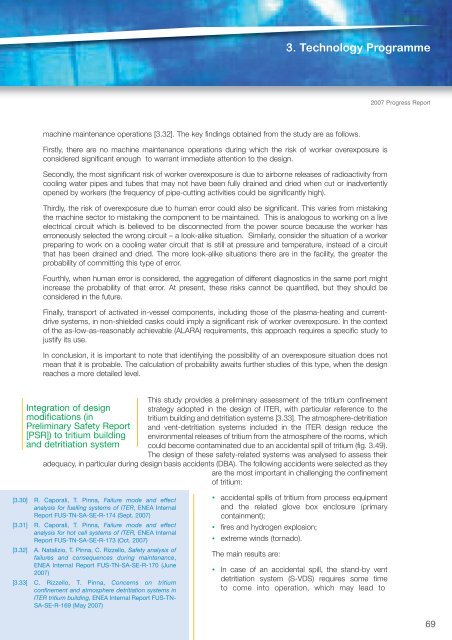Fusion Programme - ENEA - Fusione
Fusion Programme - ENEA - Fusione
Fusion Programme - ENEA - Fusione
- No tags were found...
Create successful ePaper yourself
Turn your PDF publications into a flip-book with our unique Google optimized e-Paper software.
3. Technology <strong>Programme</strong>2007 Progress Reportmachine maintenance operations [3.32]. The key findings obtained from the study are as follows.Firstly, there are no machine maintenance operations during which the risk of worker overexposure isconsidered significant enough to warrant immediate attention to the design.Secondly, the most significant risk of worker overexposure is due to airborne releases of radioactivity fromcooling water pipes and tubes that may not have been fully drained and dried when cut or inadvertentlyopened by workers (the frequency of pipe-cutting activities could be significantly high).Thirdly, the risk of overexposure due to human error could also be significant. This varies from mistakingthe machine sector to mistaking the component to be maintained. This is analogous to working on a liveelectrical circuit which is believed to be disconnected from the power source because the worker haserroneously selected the wrong circuit – a look-alike situation. Similarly, consider the situation of a workerpreparing to work on a cooling water circuit that is still at pressure and temperature, instead of a circuitthat has been drained and dried. The more look-alike situations there are in the facility, the greater theprobability of committing this type of error.Fourthly, when human error is considered, the aggregation of different diagnostics in the same port mightincrease the probability of that error. At present, these risks cannot be quantified, but they should beconsidered in the future.Finally, transport of activated in-vessel components, including those of the plasma-heating and currentdrivesystems, in non-shielded casks could imply a significant risk of worker overexposure. In the contextof the as-low-as-reasonably achievable (ALARA) requirements, this approach requires a specific study tojustify its use.In conclusion, it is important to note that identifying the possibility of an overexposure situation does notmean that it is probable. The calculation of probability awaits further studies of this type, when the designreaches a more detailed level.This study provides a preliminary assessment of the tritium confinementIntegration of design strategy adopted in the design of ITER, with particular reference to themodifications (intritium building and detritiation systems [3.33]. The atmosphere-detritiationPreliminary Safety Report and vent-detritiation systems included in the ITER design reduce the[PSR]) to tritium building environmental releases of tritium from the atmosphere of the rooms, whichand detritiation system could become contaminated due to an accidental spill of tritium (fig. 3.49).The design of these safety-related systems was analysed to assess theiradequacy, in particular during design basis accidents (DBA). The following accidents were selected as theyare the most important in challenging the confinementof tritium:[3.30] R. Caporali, T. Pinna, Failure mode and effectanalysis for fuelling systems of ITER, <strong>ENEA</strong> InternalReport FUS-TN-SA-SE-R-174 (Sept. 2007)[3.31] R. Caporali, T. Pinna, Failure mode and effectanalysis for hot cell systems of ITER, <strong>ENEA</strong> InternalReport FUS-TN-SA-SE-R-173 (Oct. 2007)[3.32] A. Natalizio, T. Pinna, C. Rizzello, Safety analysis offailures and consequences during maintenance,<strong>ENEA</strong> Internal Report FUS-TN-SA-SE-R-170 (June2007)[3.33] C. Rizzello, T. Pinna, Concerns on tritiumconfinement and atmosphere detritiation systems inITER tritium building, <strong>ENEA</strong> Internal Report FUS-TN-SA-SE-R-169 (May 2007)• accidental spills of tritium from process equipmentand the related glove box enclosure (primarycontainment);• fires and hydrogen explosion;• extreme winds (tornado).The main results are:• In case of an accidental spill, the stand-by ventdetritiation system (S-VDS) requires some timeto come into operation, which may lead to69













